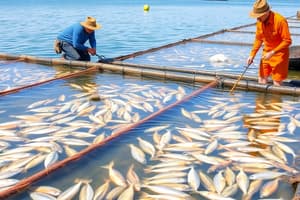Podcast
Questions and Answers
What is the primary purpose of aquaculture in reservoirs?
What is the primary purpose of aquaculture in reservoirs?
- To promote tourism
- To reduce water pollution
- To produce food, restore ecosystems, and enhance biodiversity (correct)
- To generate electricity
What type of aquaculture involves raising aquatic animals or plants in enclosures or cages?
What type of aquaculture involves raising aquatic animals or plants in enclosures or cages?
- Cage culture (correct)
- Integrated multi-trophic aquaculture
- Reservoir-based culture
- Pond-based culture
What is a benefit of aquaculture in reservoirs?
What is a benefit of aquaculture in reservoirs?
- Decreased food security
- Increased water pollution
- Reduced economic benefits
- Enhanced biodiversity (correct)
What is a challenge of aquaculture in reservoirs?
What is a challenge of aquaculture in reservoirs?
What is necessary to mitigate the negative impacts of aquaculture in reservoirs?
What is necessary to mitigate the negative impacts of aquaculture in reservoirs?
What is a function of regulatory frameworks in aquaculture in reservoirs?
What is a function of regulatory frameworks in aquaculture in reservoirs?
What can be a consequence of farmed species escaping from aquaculture operations in reservoirs?
What can be a consequence of farmed species escaping from aquaculture operations in reservoirs?
What may compete with aquaculture in reservoirs for water resources?
What may compete with aquaculture in reservoirs for water resources?
Flashcards are hidden until you start studying
Study Notes
Definition and Purpose
- Aquaculture in reservoirs: the practice of cultivating aquatic plants and animals in reservoirs, which are artificial lakes created by constructing a dam across a river or stream.
- Purpose: to produce food, restore ecosystems, and enhance biodiversity.
Types of Aquaculture in Reservoirs
- Cage culture: fish or other aquatic animals are raised in enclosures or cages submerged in the reservoir.
- Pond-based culture: aquatic plants and animals are raised in ponds or tanks within the reservoir.
- Integrated multi-trophic aquaculture: combines different species at different trophic levels in the same system, mimicking natural ecosystems.
Benefits
- Food security: provides a source of protein-rich food for human consumption.
- Economic benefits: generates income and employment opportunities for local communities.
- Ecosystem restoration: can help restore degraded or damaged ecosystems.
- Biodiversity enhancement: can increase the variety of aquatic species in the reservoir.
Challenges and Concerns
- Water quality: aquaculture operations can impact water quality, leading to eutrophication, algal blooms, and decreased oxygen levels.
- Disease and parasites: can spread between farmed and wild species, potentially harming native populations.
- Escapees and invasive species: farmed species can escape and establish non-native populations, leading to ecosystem disruption.
- Conflicts with other water uses: aquaculture may compete with other water uses, such as irrigation, drinking water supply, or recreation.
Management and Regulation
- Regulatory frameworks: governments and regulatory bodies establish guidelines and laws to ensure sustainable and responsible aquaculture practices.
- Environmental monitoring: regular monitoring of water quality, species populations, and ecosystem health is essential to mitigate negative impacts.
- Best management practices: implementing practices that minimize environmental impacts, such as using feed with low environmental impact, managing waste, and controlling disease outbreaks.
Research and Development
- Genetic improvement: developing disease-resistant and fast-growing species to improve aquaculture productivity.
- Sustainable feed sources: researching alternative feed sources, such as plant-based or waste-based feeds, to reduce environmental impacts.
- Recirculating aquaculture systems: developing systems that recycle water and waste to minimize environmental impacts and improve efficiency.
Definition and Purpose of Aquaculture in Reservoirs
- Aquaculture in reservoirs involves cultivating aquatic plants and animals in artificial lakes created by dams across rivers or streams.
- The main purposes of aquaculture in reservoirs are to produce food, restore ecosystems, and enhance biodiversity.
Types of Aquaculture in Reservoirs
- Cage culture: raises fish or other aquatic animals in enclosures or cages submerged in reservoirs.
- Pond-based culture: raises aquatic plants and animals in ponds or tanks within reservoirs.
- Integrated multi-trophic aquaculture: combines different species at different trophic levels, mimicking natural ecosystems.
Benefits of Aquaculture in Reservoirs
- Provides a source of protein-rich food for human consumption, enhancing food security.
- Generates income and employment opportunities for local communities, contributing to economic benefits.
- Helps restore degraded or damaged ecosystems and increases aquatic species variety, enhancing biodiversity.
Challenges and Concerns of Aquaculture in Reservoirs
- Aquaculture operations can impact water quality, leading to eutrophication, algal blooms, and decreased oxygen levels.
- Disease and parasites can spread between farmed and wild species, harming native populations.
- Farmed species can escape and establish non-native populations, disrupting ecosystems.
- Aquaculture may compete with other water uses, such as irrigation, drinking water supply, or recreation.
Management and Regulation of Aquaculture in Reservoirs
- Regulatory frameworks establish guidelines and laws for sustainable and responsible aquaculture practices.
- Environmental monitoring is essential to mitigate negative impacts on water quality and ecosystems.
- Implementing best management practices minimizes environmental impacts, such as using low-impact feed and managing waste.
Research and Development in Aquaculture in Reservoirs
- Genetic improvement involves developing disease-resistant and fast-growing species to improve productivity.
- Sustainable feed sources are being researched, including plant-based or waste-based feeds, to reduce environmental impacts.
- Recirculating aquaculture systems are being developed to recycle water and waste, minimizing environmental impacts and improving efficiency.
Studying That Suits You
Use AI to generate personalized quizzes and flashcards to suit your learning preferences.




